#AI-Powered Factory Automation
Explore tagged Tumblr posts
Text
Revolutionize your manufacturing process with generative AI: predictive maintenance, enhanced design, improved quality control, and streamlined supply chains. Embrace the future!
#AI In Inventory Management#AI-Powered Manufacturing Data Analysis#Generative AI In Smart Factories#AI In Manufacturing Innovation#Generative AI For Production Planning#AI In Operational Efficiency#AI-Driven Manufacturing Transformation#Generative AI For Lean Manufacturing#AI In Manufacturing Logistics#AI-Enhanced Production Processes#Generative AI For Equipment Monitoring#AI In Supply Chain Optimization#Generative AI For Manufacturing Agility#AI-Powered Factory Automation#AI In Process Control#Generative AI For Production Optimization
0 notes
Text
AI in Automotive Manufacturing 2025: Driving the Future of Smart Production
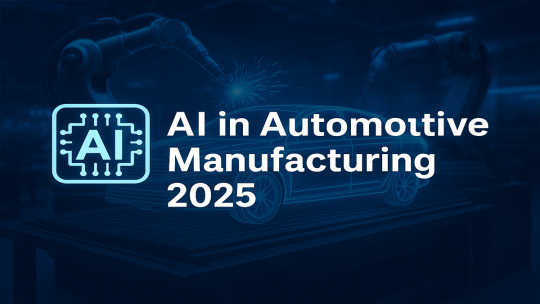
Introduction
The automotive industry is undergoing a paradigm shift, with artificial intelligence (AI) playing a crucial role in transforming manufacturing processes. AI in automotive manufacturing 2025 is set to revolutionize production efficiency, quality control, and supply chain optimization. From predictive maintenance to autonomous quality inspection, AI is enhancing every aspect of car production, making factories smarter and more efficient. In this article, we explore how AI is reshaping the automotive manufacturing landscape, its benefits, and the future it holds.
The Role of AI in Automotive Manufacturing
AI is bringing unprecedented efficiency and precision to car manufacturing by enabling automation, predictive analytics, and intelligent decision-making. Key areas where AI is making a significant impact include:
1. Smart Robotics & Automation
AI-driven robotic arms are streamlining manufacturing processes by executing tasks such as welding, painting, and assembly with extreme accuracy. Unlike traditional robots, AI-powered machines adapt to new tasks through machine learning algorithms, reducing downtime and improving productivity.
2. Predictive Maintenance
Predictive maintenance powered by AI helps automotive manufacturers prevent unexpected equipment failures. By analyzing data from IoT sensors, AI can predict machinery breakdowns and recommend timely maintenance, reducing downtime and costs.
3. AI-Powered Quality Control
Traditional quality control methods are being replaced by AI-driven vision inspection systems that detect even the smallest defects in car components. AI ensures consistency and precision, minimizing recalls and warranty claims.
4. Supply Chain Optimization
AI is optimizing the automotive supply chain by predicting demand, managing inventory, and identifying disruptions before they occur. This helps manufacturers maintain a steady production flow while reducing costs and improving efficiency.
5. Autonomous Vehicles in Manufacturing Plants
Automakers are integrating AI-powered autonomous vehicles within factories to transport materials, enhancing efficiency and reducing human intervention in logistics.
Benefits of AI in Automotive Manufacturing
The integration of AI in car manufacturing offers numerous advantages, including:
• Enhanced Efficiency: AI automates repetitive tasks, reducing manual labor and increasing production speed.
• Cost Savings: Predictive analytics minimize operational costs by preventing breakdowns and optimizing resource allocation.
• Improved Product Quality: AI-driven quality control ensures defect-free components, leading to higher customer satisfaction.
• Sustainability: AI helps reduce waste and energy consumption, making manufacturing more environmentally friendly.
• Workforce Safety: AI-powered robots take over hazardous tasks, improving workplace safety for employees.
Challenges in Implementing AI in Automotive Manufacturing
Despite its benefits, AI adoption in automotive manufacturing faces several challenges:
• High Initial Investment: Implementing AI-driven systems requires significant investment in technology and infrastructure.
• Skilled Workforce: Companies need trained professionals who can manage AI systems effectively.
• Data Privacy & Security: Protecting sensitive manufacturing data from cyber threats remains a critical concern.
• Integration Complexity: AI systems must be seamlessly integrated into existing manufacturing processes, requiring careful planning.
The Future of AI in Automotive Manufacturing
By 2025, AI is expected to become an integral part of every automotive production process. Key future trends include:
• Fully Automated Factories: AI will lead to the development of smart factories with minimal human intervention.
• AI-Driven Customization: Personalized car manufacturing will be possible, allowing customers to customize vehicle features in real time.
• Sustainable Manufacturing: AI will enhance sustainability by optimizing resource usage and reducing emissions.
• Collaboration Between AI & Humans: AI will complement human workers, enabling them to focus on high-value tasks while AI handles repetitive processes.
Conclusion
The AI in automotive manufacturing 2025 revolution is transforming the industry by improving efficiency, quality, and sustainability. As automakers embrace AI-driven technologies, they will unlock new opportunities for growth and innovation. While challenges exist, the benefits of AI far outweigh the hurdles, making it a game-changer for the future of car manufacturing.
#tagbin#writers on tumblr#artificial intelligence#technology#ai trends 2025#AI in automotive manufacturing 2025#AI in car production#artificial intelligence in auto industry#AI-driven vehicle manufacturing#smart factories in automotive#AI-powered car assembly#robotics in automobile production#future of AI in automotive#AI automation in car factories#machine learning in automotive industry
0 notes
Text
Advanced robotics is transforming engineering by automating complex tasks with AI and machine learning. Industries like healthcare, manufacturing, and logistics benefit from intelligent machines that enhance efficiency and precision. Unlike traditional automation, AI-powered robots adapt, learn, and improve over time. At M.Kumarasamy College of Engineering (MKCE), students engage with cutting-edge robotics through hands-on projects. The institution’s labs foster innovation in autonomous systems and adaptive algorithms. Emerging trends like swarm robotics and soft robotics are revolutionizing automation. MKCE integrates interdisciplinary learning, merging robotics with AI and mechanical engineering. Industry partnerships ensure students gain real-world exposure to advanced technologies. The college also emphasizes sustainable robotics solutions for a greener future. As robotics continues to evolve, MKCE remains at the forefront of this transformative field.
To know more : https://mkce.ac.in/blog/advanced-robotics-as-the-next-frontier-in-engineering-automation/
#private college#best engineering college in karur#mkce college#best engineering college#top 10 colleges in tn#engineering college in karur#mkce#mkce.ac.in#engineering college#libary#AI-Powered Automation#Smart Factories#Green Automation#Robotics and Sustainability#Next-Gen Robotics#Robotics Research Projects#Robotics Hackathons#Hands-on Robotics Learning#Robotics Lab Innovations#Robotics Engineering#Edge Computing in Robotics#Human-Robot Collaboration (Cobots)
0 notes
Text
Energy Power automate in pune | India
An inverter, charge controllers, a battery that stores energy, and solar panels that gather sunlight are the essential components of a solar power system. If these were absent, it would be inaccurate to state that the system is functioning well. Your smart house will be energy-efficient and optimized for usage thanks to energy automation, which links the solar power system to the primary energy operations.
#Energy and Power Automation Solutions#Special Purpose Machine Automation | AI-based vision sensors#Warehouse Automation Solutions#Material Handling Processes#Partner in Factory Automation#Electrical & software solutions#Process Automation Partner
0 notes
Text
AI turns Amazon coders into Amazon warehouse workers

HEY SEATTLE! I'm appearing at the Cascade PBS Ideas Festival NEXT SATURDAY (May 31) with the folks from NPR's On The Media!

On a recent This Machine Kills episode, guest Hagen Blix described the ultimate form of "AI therapy" with a "human in the loop":
https://soundcloud.com/thismachinekillspod/405-ai-is-the-demon-god-of-capital-ft-hagen-blix
One actual therapist is just having ten chat GPT windows open where they just like have five seconds to interrupt the chatGPT. They have to scan them all and see if it says something really inappropriate. That's your job, to stop it.
Blix admits that's not where therapy is at…yet, but he references Laura Preston's 2023 N Plus One essay, "HUMAN_FALLBACK," which describes her as a backstop to a real-estate "virtual assistant," that masqueraded as a human handling the queries that confused it, in a bid to keep the customers from figuring out that they were engaging with a chatbot:
https://www.nplusonemag.com/issue-44/essays/human_fallback/
This is what makes investors and bosses slobber so hard for AI – a "productivity" boost that arises from taking away the bargaining power of workers so that they can be made to labor under worse conditions for less money. The efficiency gains of automation aren't just about using fewer workers to achieve the same output – it's about the fact that the workers you fire in this process can be used as a threat against the remaining workers: "Do your job and shut up or I'll fire you and give your job to one of your former colleagues who's now on the breadline."
This has been at the heart of labor fights over automation since the Industrial Revolution, when skilled textile workers took up the Luddite cause because their bosses wanted to fire them and replace them with child workers snatched from Napoleonic War orphanages:
https://pluralistic.net/2023/09/26/enochs-hammer/#thats-fronkonsteen
Textile automation wasn't just about producing more cloth – it was about producing cheaper, worse cloth. The new machines were so easy a child could use them, because that's who was using them – kidnapped war orphans. The adult textile workers the machines displaced weren't afraid of technology. Far from it! Weavers used the most advanced machinery of the day, and apprenticed for seven years to learn how to operate it. Luddites had the equivalent of a Masters in Engineering from MIT.
Weavers' guilds presented two problems for their bosses: first, they had enormous power, thanks to the extensive training required to operate their looms; and second, they used that power to regulate the quality of the goods they made. Even before the Industrial Revolution, weavers could have produced more cloth at lower prices by skimping on quality, but they refused, out of principle, because their work mattered to them.
Now, of course weavers also appreciated the value of their products, and understood that innovations that would allow them to increase their productivity and make more fabric at lower prices would be good for the world. They weren't snobs who thought that only the wealthy should go clothed. Weavers had continuously adopted numerous innovations, each of which increased the productivity and the quality of their wares.
Long before the Luddite uprising, weavers had petitioned factory owners and Parliament under the laws that guaranteed the guilds the right to oversee textile automation to ensure that it didn't come at the price of worker power or the quality of the textiles the machines produced. But the factory owners and their investors had captured Parliament, which ignored its own laws and did nothing as the "dark, Satanic mills" proliferated. Luddites only turned to property destruction after the system failed them.
Now, it's true that eventually, the machines improved and the fabric they turned out matched and exceeded the quality of the fabric that preceded the Industrial Revolution. But there's nothing about the way the Industrial Revolution unfolded – increasing the power of capital to pay workers less and treat them worse while flooding the market with inferior products – that was necessary or beneficial to that progress. Every other innovation in textile production up until that time had been undertaken with the cooperation of the guilds, who'd ensured that "progress" meant better lives for workers, better products for consumers, and lower prices. If the Luddites' demands for co-determination in the Industrial Revolution had been met, we might have gotten to the same world of superior products at lower costs, but without the immiseration of generations of workers, mass killings to suppress worker uprisings, and decades of defective products being foisted on the public.
So there are two stories about automation and labor: in the dominant narrative, workers are afraid of the automation that delivers benefits to all of us, stand in the way of progress, and get steamrollered for their own good, as well as ours. In the other narrative, workers are glad to have boring and dangerous parts of their work automated away and happy to produce more high-quality goods and services, and stand ready to assess and plan the rollout of new tools, and when workers object to automation, it's because they see automation being used to crush them and worsen the outputs they care about, at the expense of the customers they care for.
In modern automation/labor theory, this debate is framed in terms of "centaurs" (humans who are assisted by technology) and "reverse-centaurs" (humans who are conscripted to assist technology):
https://pluralistic.net/2023/04/12/algorithmic-wage-discrimination/#fishers-of-men
There are plenty of workers who are excited at the thought of using AI tools to relieve them of some drudgework. To the extent that these workers have power over their bosses and their working conditions, that excitement might well be justified. I hear a lot from programmers who work on their own projects about how nice it is to have a kind of hypertrophied macro system that can generate and tweak little automated tools on the fly so the humans can focus on the real, chewy challenges. Those workers are the centaurs, and it's no wonder that they're excited about improved tooling.
But the reverse-centaur version is a lot darker. The reverse-centaur coder is an assistant to the AI, charged with being a "human in the loop" who reviews the material that the AI produces. This is a pretty terrible job to have.
For starters, the kinds of mistakes that AI coders make are the hardest mistakes for human reviewers to catch. That's because LLMs are statistical prediction machines, spicy autocomplete that works by ingesting and analyzing a vast corpus of written materials and then producing outputs that represent a series of plausible guesses about which words should follow one another. To the extent that the reality the AI is participating in is statistically smooth and predictable, AI can often make eerily good guesses at words that turn into sentences or code that slot well into that reality.
But where reality is lumpy and irregular, AI stumbles. AI is intrinsically conservative. As a statistically informed guessing program, it wants the future to be like the past:
https://reallifemag.com/the-apophenic-machine/
This means that AI coders stumble wherever the world contains rough patches and snags. Take "slopsquatting." For the most part, software libraries follow regular naming conventions. For example, there might be a series of text-handling libraries with names like "text.parsing.docx," "text.parsing.xml," and "text.parsing.markdown." But for some reason – maybe two different projects were merged, or maybe someone was just inattentive – there's also a library called "text.txt.parsing" (instead of "text.parsing.txt").
AI coders are doing inference based on statistical analysis, and anyone inferring what the .txt parsing library is called would guess, based on the other libraries, that it was "text.parsing.txt." And that's what the AI guesses, and so it tries to import that library to its software projects.
This creates a new security vulnerability, "slopsquatting," in which a malicious actor creates a library with the expected name, which replicates the functionality of the real library, but also contains malicious code:
https://www.theregister.com/2025/04/12/ai_code_suggestions_sabotage_supply_chain/
Note that slopsquatting errors are extremely hard to spot. As is typical with AI coding errors, these are errors that are based on continuing a historical pattern, which is the sort of thing our own brains do all the time (think of trying to go up a step that isn't there after climbing to the top of a staircase). Notably, these are very different from the errors that a beginning programmer whose work is being reviewed by a more senior coder might make. These are the very hardest errors for humans to spot, and these are the errors that AIs make the most, and they do so at machine speed:
https://pluralistic.net/2024/04/23/maximal-plausibility/#reverse-centaurs
To be a human in the loop for an AI coder, a programmer must engage in sustained, careful, line-by-line and command-by-command scrutiny of the code. This is the hardest kind of code to review, and maintaining robotic vigilance over long periods at high speeds is something humans are very bad at. Indeed, it's the kind of task we try very hard to automate, since machines are much better at being machineline than humans are. This is the essence of reverse-centaurism: when a human is expected to act like a machine in order to help the machine do something it can't do.
Humans routinely fail at spotting these errors, unsurprisingly. If the purpose of automation is to make superior goods at lower prices, then this would be a real concern, since a reverse-centaur coding arrangement is bound to produce code with lurking, pernicious, especially hard-to-spot bugs that present serious risks to users. But if the purpose of automation is to discipline labor – to force coders to accept worse conditions and pay – irrespective of the impact on quality, then AI is the perfect tool for the job. The point of the human isn't to catch the AI's errors so much as it is to catch the blame for the AI's errors – to be what Madeleine Clare Elish calls a "moral crumple zone":
https://estsjournal.org/index.php/ests/article/view/260
As has been the case since the Industrial Revolution, the project of automation isn't just about increasing productivity, it's about weakening labor power as a prelude to lowering quality. Take what's happened to the news industry, where mass layoffs are being offset by AI tools. At Hearst's King Features Syndicates, a single writer was charged with producing over 30 summer guides, the entire package:
https://www.404media.co/viral-ai-generated-summer-guide-printed-by-chicago-sun-times-was-made-by-magazine-giant-hearst/
That is an impossible task, which is why the writer turned to AI to do his homework, and then, infamously, published a "summer reading guide" that was full of nonexistent books that were hallucinated by a chatbot:
https://www.404media.co/chicago-sun-times-prints-ai-generated-summer-reading-list-with-books-that-dont-exist/
Most people reacted to this story as a consumer issue: they were outraged that the world was having a defective product foisted upon it. But the consumer issue here is downstream from the labor issue: when the writers at King Features Syndicate are turned into reverse-centaurs, they will inevitably produce defective outputs. The point of the worker – the "human in the loop" – isn't to supervise the AI, it's to take the blame for the AI. That's just what happened, as this poor schmuck absorbed an internet-sized rasher of shit flung his way by outraged social media users. After all, it was his byline on the story, not the chatbot's. He's the moral crumple-zone.
The implication of this is that consumers and workers are class allies in the automation wars. The point of using automation to weaken labor isn't just cheaper products – it's cheaper, defective products, inflicted on the unsuspecting and defenseless public who are no longer protected by workers' professionalism and pride in their jobs.
That's what's going on at Duolingo, where CEO Luis von Ahn created a firestorm by announcing mass firings of human language instructors, who would be replaced by AI. The "AI first" announcement pissed off Duolingo's workers, of course, but what caught von Ahn off-guard was how much this pissed off Duolingo's users:
https://tech.slashdot.org/story/25/05/25/0347239/duolingo-faces-massive-social-media-backlash-after-ai-first-comments
But of course, this makes perfect sense. After all, language-learners are literally incapable of spotting errors in the AI instruction they receive. If you spoke the language well enough to spot the AI's mistakes, you wouldn't need Duolingo! I don't doubt that there are countless ways in which AIs could benefit both language learners and the Duolingo workers who develop instructional materials, but for that to happen, workers' and learners' needs will have to be the focus of AI integration. Centaurs could produce great language learning materials with AI – but reverse-centaurs can only produce slop.
Unsurprisingly, many of the most successful AI products are "bossware" tools that let employers monitor and discipline workers who've been reverse-centaurized. Both blue-collar and white-collar workplaces have filled up with "electronic whips" that monitor and evaluate performance:
https://pluralistic.net/2024/08/02/despotism-on-demand/#virtual-whips
AI can give bosses "dashboards" that tell them which Amazon delivery drivers operate their vehicles with their mouths open (Amazon doesn't let its drivers sing on the job). Meanwhile, a German company called Celonis will sell your boss a kind of AI phrenology tool that assesses your "emotional quality" by spying on you while you work:
https://crackedlabs.org/en/data-work/publications/processmining-algomanage
Tech firms were among the first and most aggressive adopters of AI-based electronic whips. But these whips weren't used on coders – they were reserved for tech's vast blue-collar and contractor workforce: clickworkers, gig workers, warehouse workers, AI data-labelers and delivery drivers.
Tech bosses tormented these workers but pampered their coders. That wasn't out of any sentimental attachment to tech workers. Rather, tech bosses were afraid of tech workers, because tech workers possess a rare set of skills that can be harnessed by tech firms to produce gigantic returns. Tech workers have historically been princes of labor, able to command high salaries and deferential treatment from their bosses (think of the amazing tech "campus" perks), because their scarcity gave them power.
It's easy to predict how tech bosses would treat tech workers if they could get away with it – just look how they treat workers they aren't afraid of. Just like the textile mill owners of the Industrial Revolution, the thing that excites tech bosses about AI is the possibility of cutting off a group of powerful workers at the knees. After all, it took more than a century for strong labor unions to match the power that the pre-Industrial Revolution guilds had. If AI can crush the power of tech workers, it might buy tech bosses a century of free rein to shift value from their workforce to their investors, while also doing away with pesky Tron-pilled workers who believe they have a moral obligation to "fight for the user."
William Gibson famously wrote, "The future is here, it's just not evenly distributed." The workers that tech bosses don't fear are living in the future of the workers that tech bosses can't easily replace.
This week, the New York Times's veteran Amazon labor report Noam Scheiber published a deeply reported piece about the experience of coders at Amazon in the age of AI:
https://www.nytimes.com/2025/05/25/business/amazon-ai-coders.html
Amazon CEO Andy Jassy is palpably horny for AI coders, evidenced by investor memos boasting of AI's returns in "productivity and cost avoidance" and pronouncements about AI saving "the equivalent of 4,500 developer-years":
https://www.linkedin.com/posts/andy-jassy-8b1615_one-of-the-most-tedious-but-critical-tasks-activity-7232374162185461760-AdSz/
Amazon is among the most notorious abusers of blue-collar labor, the workplace where everyone who doesn't have a bullshit laptop job is expected to piss in a bottle and spend an unpaid hour before and after work going through a bag- and body-search. Amazon's blue-collar workers are under continuous, totalizing, judging AI scrutiny that scores them based on whether their eyeballs are correctly oriented, whether they take too long to pick up an object, whether they pee too often. Amazon warehouse workers are injured at three times national average. Amazon AIs scan social media for disgruntled workers talking about unions, and Amazon has another AI tool that predicts which shops and departments are most likely to want to unionize.
Scheiber's piece describes what it's like to be an Amazon tech worker who's getting the reverse-centaur treatment that has heretofore been reserved for warehouse workers and drivers. They describe "speedups" in which they are moved from writing code to reviewing AI code, their jobs transformed from solving chewy intellectual puzzles to racing to spot hard-to-find AI coding errors as a clock ticks down. Amazon bosses haven't ordered their tech workers to use AI, just raised their quotas to a level that can't be attained without getting an AI to do most of the work – just like the Chicago Sun-Times writer who was expected to write all 30 articles in the summer guide package on his own. No one made him use AI, but he wasn't going to produce 30 articles on deadline without a chatbot.
Amazon insists that it is treating AI as an assistant for its coders, but the actual working conditions make it clear that this is a reverse-centaur transformation. Scheiber discusses a dissident internal group at Amazon called Amazon Employees for Climate Justice, who link the company's use of AI to its carbon footprint. Beyond those climate concerns, these workers are treating AI as a labor issue.
Amazon's coders have been making tentative gestures of solidarity towards its blue-collar workforce since the pandemic broke out, walking out in support of striking warehouse workers (and getting fired for doing so):
https://pluralistic.net/2020/04/14/abolish-silicon-valley/#hang-together-hang-separately
But those firings haven't deterred Amazon's tech workers from making common cause with their comrades on the shop floor:
https://pluralistic.net/2021/01/19/deastroturfing/#real-power
When techies describe their experience of AI, it sometimes sounds like they're describing two completely different realities – and that's because they are. For workers with power and control, automation turns them into centaurs, who get to use AI tools to improve their work-lives. For workers whose power is waning, AI is a tool for reverse-centaurism, an electronic whip that pushes them to work at superhuman speeds. And when they fail, these workers become "moral crumple zones," absorbing the blame for the defective products their bosses pushed out in order to goose profits.
As ever, what a technology does pales in comparison to who it does it for and who it does it to.

If you'd like an essay-formatted version of this post to read or share, here's a link to it on pluralistic.net, my surveillance-free, ad-free, tracker-free blog:
https://pluralistic.net/2025/05/27/rancid-vibe-coding/#class-war

Image: Cryteria (modified) https://commons.wikimedia.org/wiki/File:HAL9000.svg
CC BY 3.0 https://creativecommons.org/licenses/by/3.0/deed.en
354 notes
·
View notes
Text
🌙✨2025, The Year Everything Changes, and Why Astrologers are sweating✨🌙
February 11th 2025
2025: The Year Everything Changes – And Why Astrologers Are Sweating
Right, listen up—2025 is not a normal year.
If you’ve been feeling like the world is on the edge of something massive, you’re not wrong. This isn’t just another ‘big astrology year’ where Mercury retrogrades a bit, and your ex reappears. This is one of those rare years where history shifts permanently—a complete collapse of the old world and the birth of something new.
And astrologers? They’re sweating.
Because when we look back, the last time we saw these planetary shifts, entire empires fell, revolutions kicked off, and the world as people knew it ended.
So let’s talk about what’s coming—and why 2025 will be one of the most significant years of our lifetime.
☠️ 1. Pluto in Aquarius (2024–2043): The Last Time? Revolutions, Science, and the Fall of Monarchies
Pluto—the planet of death, rebirth, power, and transformation—has just moved into Aquarius, where it’ll stay for nearly 20 years. The last time Pluto was here? The late 1700s.
And what happened? Absolute chaos and revolution.
🔥 The American Revolution (1775–1783) – The United States was literally born out of rebellion during Pluto in Aquarius. A bunch of colonies decided they didn’t fancy being ruled by a king, and boom—democracy.
🔪 The French Revolution (1789–1799) – The people of France had enough of their monarchy and executed their king and queen. It wasn’t just a political shift—it was a complete destruction of the old system.
⚙️ The First Industrial Revolution – Factories, steam engines, and machinery completely transformed the way people worked and lived. It was the beginning of mass urbanisation and capitalism as we know it.
🧠 The Age of Enlightenment – Science, philosophy, and new political ideas challenged religion and traditional authority. Think of it as the era where people started saying, “Wait… why are we listening to kings and priests when we can use reason instead?”
What This Means for 2025+
• The collapse of old power structures – Governments, corporations, and billionaires will struggle to keep control.
• Technology will explode – AI, automation, and robotics will change society forever—and not everyone will be happy about it.
• Decentralisation of power – Cryptocurrency, AI governance, and digital societies could replace traditional leadership.
• Mass protests and revolutions – People are done with inequality. Expect uprisings, movements, and shifts towards direct democracy.
🌊 2. Neptune in Aries (2025–2039): War, Crusades, and Ideological Clashes
Neptune—the planet of dreams, illusions, and spirituality—moves into Aries, the sign of war and action, for the first time since 1861. The last time Neptune was here? The world was on fire.
⚔️ The American Civil War (1861–1865) – A brutal, ideological war tore a nation apart over slavery, identity, and control.
👻 The Spiritualist Movement exploded – People became obsessed with ghosts, séances, and the afterlife, trying to communicate with the dead.
🇩🇪 The unification of Germany and Italy – Entire nations were restructured through wars and nationalism.
📖 Karl Marx wrote Das Kapital – The book that inspired communism and socialism was published, challenging capitalism and shaping global politics for centuries.
What This Means for 2025+
• New ideological wars – AI vs. humans? Capitalism vs. alternative economies? The battleground is shifting.
• A rise in spiritual extremism – New religious movements and cults will take advantage of uncertainty.
• Economic collapse and transformation – Just like Marx’s work changed the global economy, we’re heading for a massive financial shift—and not everyone will like it.
• A generation searching for meaning – Expect huge spiritual awakenings—but also dangerous movements trying to manipulate people.
💡 3. Uranus in Gemini (2025–2033): The Last Time? World War II, Propaganda, and Technological Leaps
Uranus—the planet of disruption, rebellion, and technology—moves into Gemini, the sign of communication, media, and ideas. And last time this happened (1942–1949), the world saw:
💣 World War II’s final years – The atomic bomb changed warfare forever.
📡 The rise of propaganda – Governments used radio, newspapers, and film to shape public opinion like never before.
🖥 The birth of modern computing – The digital world was literally born during this transit.
What This Means for 2025+
• AI-generated propaganda – Expect deepfakes, misinformation, and manipulated media so advanced that reality itself will be questioned.
• A new digital consciousness – Just like the 1940s brought TV and computing, we’re heading for another radical shift in how we communicate.
⚖️ 4. The Saturn-Neptune Conjunction (Feb 2026): The Collapse of Illusions
Every 36 years, Saturn and Neptune meet up, exposing what’s real and what’s a lie. The last times?
🔴 1989 – The Berlin Wall falls, the USSR collapses, the Cold War ends.
⚠️ 1953 – The discovery of DNA, but also Cold War paranoia and McCarthyism.
☠️ 1917 – The Russian Revolution, World War I intensifies.
What This Means for 2025-2026
• Major governments or institutions could collapse.
• Radical shifts in global power.
• Mass awakenings—some enlightening, some deeply disillusioning.
⏳ 2025: A Point of No Return
Looking at all of this together, 2025 isn’t just ‘a big year’—it’s a turning point in history.
The last time these planetary shifts happened, the world was never the same again. And this time? The stakes are even higher.
🔮 AI and tech will change everything.
🔥 People will rise up against broken systems.
⚔️ Wars—both literal and ideological—will reshape power.
⚡ A new world will be born.
The old ways are dying—and something new is taking their place. The question is: Are we ready?
Follow The Lantern’s
Glow

#2025#astrology#paganism#folklore#history#magic#transitions#game changer#revolution#aries#taurus moon#gemini horoscope#cancer horoscope#leo astrology#virgo horoscope#libra#scorpio#sagittarius#capricorn things#aquarius#pisces#cycles
26 notes
·
View notes
Text
I hate "the AI future"
My main training is in IT, and I was told often that they don't need me - they got "AI". So I worked a bit with art to make ends meet. "Oh, why should we commission you? We got AI". So now I do some work that I am not qualified for and only can do it because it is not heavy work. I am able to do it, but it is not even at minimum wage.
And I am lucky that I have that. I went to manual labour places, where the foreman looked at me, and went "sorry, no. Please look elsewhere". I was told I am overqualified to be a janitor or a server. I was told I need even more stuff I can't afford to do shelf stacking or delivering pizza.
So... "AI" will take our jobs, so when we can't do things - where will we get money? WHO will be able to buy any of the slop being tossed out? It is a monopoly, because these "AI" companies all made their internet scraping machines. We can't really fix this any more, I fear, but...
People won't care. They don't want to care. It's not something you can fix if we install a fully automated gay space communism tomorrow - because this is using human apathy for the way it can spread. The future generations will "enjoy" the mass produced slop, and wonder why they feel empty.
You know, I think the major fault to it is because people were enamoured by the "free" stuff, even as the real costs came out - artists being fired, insane power costs, water and electricity bills well beyond a smaller developed country, the whole market being slowly overtaken by megacorps and silicon valley techbros, and so on - and it is understandable. It was a fun toy and a strange little tool, but now that this was found to "work", the same people who want you to get used to not own the items you buy and hold them hostage behind service costs want you to get used to it.
This is just going to collapse on itself. Like buttcoins and eneftees, the market got disrupted for a moment by people who don't understand the systems they want to replace, but it went from "monopoly money useful only for drugs" to "nobody will have a job that can not be automated, so everyone has to fight to become a factory worker or server"; and thus, here, nobody will be able to buy anything. It's like they figured out how to become the global industrial version of the Ottoman Empire or Tsarist Russia.
Spoiler alert: it will collapse on itself when nobody can buy anything the factories and the slop machines produce, and it will collapse hard. Question is, when and how will we get back from it? Will that future be any better, or we will get another loop from incompetent techbros trying to get their stupid Torment Nexus, and then wonder why it hurts?
Anyway, I am somewhat optimistic, but it requires people to realise what the costs are for "cheap" and "easy". It never is cheap and easy.
Until that, anyone who loves their "ai" slot machines should enjoy the slop being served for the enormous costs, and happily dig in, this will be all you get if you don't stop.
#artificial intelligence#personal rant#tired of the state of tech#ever since trans people and furries got pushed out
39 notes
·
View notes
Text
Top Ways AAS Miners Make Money from Artificial Intelligence

We are living in a defining decade — one where artificial intelligence (AI) is no longer a futuristic fantasy but a central force shaping the global economy, workforce, and wealth distribution. From ChatGPT to self-driving cars, from AI-powered trading to smart factories, intelligent systems are becoming the new infrastructure of the digital world.
But as massive corporations, governments, and venture capitalists invest billions into AI, an important question arises:
“How can everyday individuals benefit from the AI revolution — not just as consumers, but as earners?”
One surprising, yet powerful answer lies at the intersection of AI and blockchain: AI-powered cloud mining. And leading that frontier is AAS MINER — the first platform to combine artificial intelligence with decentralized crypto income.
By 2030, the global AI economy is projected to contribute over $15.7 trillion USD to global GDP, according to PwC. That’s more than the current economies of China and India combined.
Key sectors already being reshaped by AI:
- Healthcare: AI diagnostics & robotic surgeries
- Manufacturing: Intelligent robotics & predictive maintenance
- Finance: Algorithmic trading & fraud detection
- E-commerce: Personalized recommendations & smart supply chains
- Energy: AI-optimized grids and consumption models

But this transformation comes with a new wealth gap — between those who build and control AI systems, and those who don't.
So how can you participate in this shift, without coding, investing millions, or launching a tech company?
AAS MINER bridges that gap. It’s an AI-powered cloud mining platform that allows anyone — from tech beginners to crypto enthusiasts — to earn daily passive income by letting AI optimize Bitcoin mining on their behalf.
You don’t buy machines. You don’t manage servers. You don’t need technical skills.
You simply create an account, choose a plan, and the AI does the rest.
It’s like owning a small piece of an AI data center — without the cost, noise, or complexity.
AAS MINER isn’t a traditional mining pool. It’s a smart mining ecosystem powered by:
- Real-time optimization: AI monitors mining pool performance, switching hash power dynamically for best rewards
- Energy-efficiency intelligence: The system routes mining tasks to the most cost-effective, eco-friendly servers worldwide
- Data-driven ROI: AI uses big data to predict block difficulty, adjust strategy, and avoid downtime
- Millisecond response: Faster-than-human decision making for maximum yield, minimum waste
This means more BTC earned, lower operational costs, and true automation — 24/7, 365 days a year.
AAS MINER offers 13 mining plans ranging from 2-day flexible options to 365-day strategic contracts. Returns vary from 1.8% to 5.2% per day, depending on duration and reinvestment.
Platform Highlights:
- $10 USDT welcome bonus
- Auto-compounding for scalable gains
- Daily login rewards & incentives
- Visual dashboards to track earnings in real-time
- Flexible withdrawals anytime
With a minimum entry of just $10, anyone can start building a passive income stream — even in uncertain global markets.
Trust is crucial, especially when it comes to automated income platforms. AAS MINER ensures:
- UK Financial Services Authority (FSA) regulation
- Cold & hot wallet separation for asset protection
- 2FA, SSL encryption, and real-time risk detection
- Smart-contract-backed earnings & blockchain transparency
In a world where:
- Traditional jobs are being automated
- Bank interest can’t keep up with inflation
- Stock markets are dominated by AI traders
- And crypto trading is increasingly unpredictable
Passive, automated systems are the future of individual wealth building.
AAS MINER gives you access to that future — right now.
You don’t need to be a machine learning expert. You don’t need to own a server farm. You just need to be early, and willing to act.
The AI economy is coming. Those who let AI work for them — will thrive.

Start Earning with AI Today:
- Claim your $10 bonus
- Choose a mining plan
- Let AI generate your daily crypto income
This is more than just mining. This is participating in the future of intelligence-powered wealth.
2 notes
·
View notes
Text
It used to be that when BMW would refit a factory to build a new car, the only way the automaker could check if the chassis would fit through the production line was to fly a team out and physically push the body through the process, making note of any snags.
Now, process engineers can simply run a simulation, sending a 3D model of the car through a near-identical digital twin of the factory. Any mistakes are spotted before the production line is built, saving time and money.
Such is the power of the industrial metaverse. Forget sending your avatar to virtual meetings with remote colleagues or poker nights with distant friends, as Mark Zuckerberg envisioned in 2021 when he changed Facebook’s name to Meta; the metaverse idea has found its killer app in manufacturing.
While the consumer version of the metaverse has stumbled, the industrial metaverse is expected to be worth $100 billion globally by 2030, according to a World Economic Forum report. In this context, the concept of the metaverse refers to a convergence of technologies including simulations, sensors, augmented reality, and 3D standards. Varvn Aryacetas, Deloitte’s AI strategy and innovation practice leader for the UK, prefers to describe it as spatial computing. “It’s about bridging the physical world with the digital world,” he says. This can include training in virtual reality, digital product design, and virtual simulations of physical spaces such as factories.
In 2022, Nvidia—the games graphics company that now powers AI with its GPUs—unveiled Omniverse, a set of tools for building simulations, running digital twins, and powering automation. It acts as a platform for the industrial metaverse. “This is a general technology—it can be used for all kinds of things,” says Rev Lebaredian, vice president of Omniverse and simulation technology at Nvidia. “I mean, representing the real world inside a computer simulation is just very useful for a lot of things—but it’s absolutely essential for building any system that has autonomy in it.”
Home improvement chain Lowe’s uses the platform to test new layouts in digital twins before building them in its physical stores. Zaha Hadid Architects creates virtual models of its projects for remote collaboration. Amazon simulates warehouses to train virtual robots before letting real ones join the floor. And BMW has built virtual models for all its sites, including its newest factory in Debrecen, Hungary, which was planned and tested virtually before construction.
To simulate its entire manufacturing process, BMW filled its virtual factories with 3D models of its cars, equipment, and even people. It created these elements in an open-source file format originated by Pixar called Universal Scene Description (OpenUSD), with Omniverse providing the technical foundation for the virtual models and BMW creating its own software layers on top, explains Matthias Mayr, virtual factory specialist at BMW.
“If you imagine a factory that would take half an hour to walk from one side to the other side, you can imagine it’s also quite a large model,” Mayr says. Hence turning to a gaming company for the technology—they know how to render scenes you can run through. Early versions of the virtual factory even had gaming-style WASD keyboard navigation, but this was dropped in favor of a click-based interface akin to exploring Google Street View in a browser, so anyone could easily find their way.
BMW also uses Omniverse for collaboration on car design and customization visualizations for customers, but a key benefit is being able to model production lines. New cars mean a new assembly process, but refitting a factory is a daunting process. Previously, key information was held in silos—production crews understood details of the assembly process, external suppliers had specs of new parts or machinery, architects had detailed building plans—and costs would pile up for every delay or mistake. “The later you find a problem, the worse it is,” says Lebaredian.
Now, problems are worked out virtually, with a central location for standardized data to be held. There’s still a critical human element: Mapping a facility requires sending a laser scanner strapped to a person running through a factory to capture point cloud data about how everything is arranged. Design engineers also need to create a 3D model of every stage of a car as it’s assembled. This level of detail allows BMW to virtually test the assembly process, complete with simulations of robotics, machines, and even human workers, as BMW has data tracking how long it takes employees to assemble a part.
The main idea is to avoid errors—does that machine even fit there?—but the system also enables optimization, such as moving a rack of components closer to a particular station to save steps for human assemblers. “You can optimize first and gain a lot of efficiency in the first production, and in the construction phase, you have fewer mistakes,” Mayr says. “It’s less error prone.”
Omniverse being a Nvidia platform, AI is naturally next. BMW is already layering in generative AI to help with navigation of its virtual models—they’re so massive that finding a particular point in the digital factory can still require asking a human expert for directions. But the aim is to use AI to optimize production lines too. “Because you have the whole data available, not just for one plant, it will be able to make good suggestions,” says Mayr—lessons learned in one factory could more easily be applied to others.
And then there’s robotics and other autonomous systems. Here, Omniverse can offer a digital space for testing before deploying in the real world, but it can also generate synthetic training data by running simulations, just as driverless car systems are trained with virtual video footage generated by AI. “Real-world experience isn’t going to come mostly from the real world—it comes from simulation,” says Lebaredian.
Aryacetas predicts that the biggest impact from the industrial metaverse will be embodied or physical AI—in other words, robots. “Robots aren’t fully there yet, but they’re rapidly training up to understand the physical world around them—and that’s being done because of these underlying spatial computing technologies,” he says.
The future of the metaverse isn’t avatars in a virtual world; it’s digital twins teaching industrial robots how to step out into the physical one.
2 notes
·
View notes
Text
Generative AI: Transforming manufacturing with predictive maintenance, innovative designs, superior quality control, and efficient supply chains. Drive innovation in your industry!
#AI-Enhanced Manufacturing Solutions#Generative AI For Factory Efficiency#AI In Supply Chain Analytics#AI-Driven Industrial Efficiency#Generative AI For Manufacturing Intelligence#AI In Production Workflows#AI-Powered Manufacturing Transformation#Generative AI For Operational Efficiency#AI In Manufacturing Cost Management#AI-Driven Factory Processes#Generative AI For Industrial Productivity#AI In Production Forecasting#AI-Powered Manufacturing Automation#Generative AI For Quality Manufacturing#AI In Operational Innovation#AI-Driven Manufacturing Analytics
0 notes
Text
The Great Satisfactory State of Play April 2025 #3
Rocky Desert Phase 4 Factories
So we went to the Dune Desert to pay one last visit to Factory Town before it gets destroyed; we popped into the Northern Forest to visit the Phase 2 factories; and now we're about to zip into the Rocky Desert to have a gander at the Phase 3 rigmarole.

And here we are on the natural bridge that connects Northern Forest to Rocky Desert. In the distance, we can see several factories, two of which feed the reactor on the opposite side of the big rock tower. So we travel west, then up the slope...
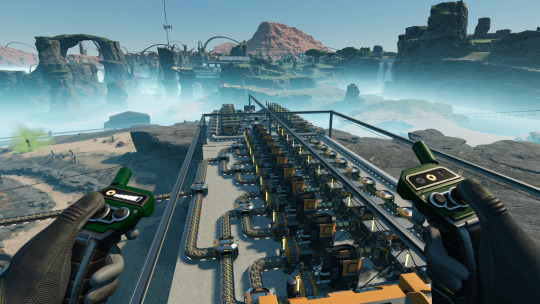
And here we have an open air silica and quickwire factory. The golden wire is crapped out in the foreground; silica is made down the back.
And where does the raw quartz come from to feed the machine? Well...
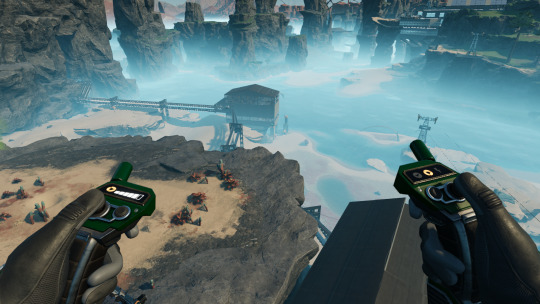
It comes from the bottom floor of the steelworks immediately below us, since the reactor doesn't use all that much silica, and I have more than enough being belted from deep within the immense cave that spans the entire width of this biome. It was a cinch to add a splitter and get that sorted!
Iron plate, silica, steel beams go out past the encased industrial beam factory in the distance, which adds much needed EIBs to the feed. Without these, the reactor stops hard.

An early WIP shot of the reactor. Obviously it's an uranium reactor, that also makes plutonium fuel rods for recycling. This was before I added the assemblers and manufacturers needed to finish that job. But that was then...

...this is now. The quickwire and silica are trained down this line to the far distant factory on the shoreline. But there's a factory closer, and newer, and it's the best example of my idea of the Stack. Shall we have a closer look?

That box in the foreground is from a mod, that allows you to tap power from train lines without needing a station. The modernist thing on the left is the caterium smeltery. That's all it does. So we skip that and hover along the power line to the skeletal one behind it. That's the Stack for electromagnetic control rods.

The idea of the Stack is simple. Each floor is dedicated to a single step in the manufacturing process. I tend to forget that because compactness. In the distant left, foundries and smelters feed copper and iron into the Stack.

Ground floor, iron and copper ingot arrival, copper sheet making. Please mind your step as getting bowled from stepping on the belts may offend (they're sent to one corner.) Going up.
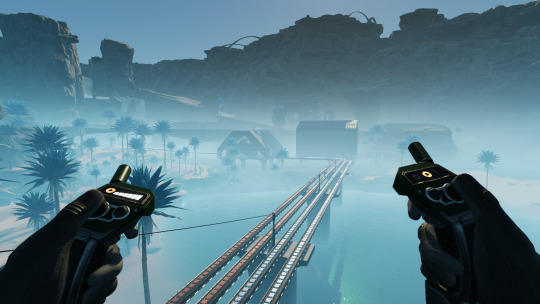
Belt bridge porn. Where was I? Oh yes.
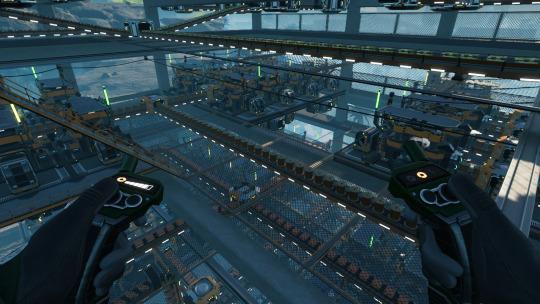
Second floor, copper wire. Note that my prefabs for 8 constructors are actually 4x4 rather than 5x5, which I use for the assemblers further up. Step to the rear of the car please.

Third floor, quickwire extrusion. This setup with the mesh flooring (from a mod) actually works quite well as it offers plenty of space for in- and output belting. Everybody up!
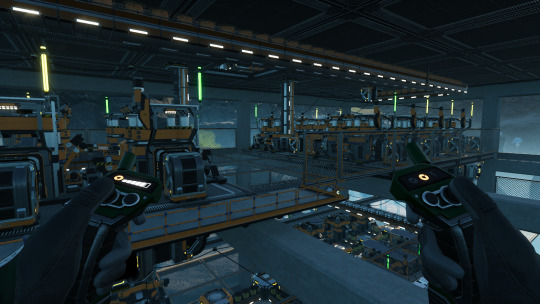
Fourth floor, iron pipe manufacture. With this half-floor we see one flaw of the Stack concept, if you consider empty floor space a flaw. And now we have to step outside the concrete pillar framework to look into the next floor up.
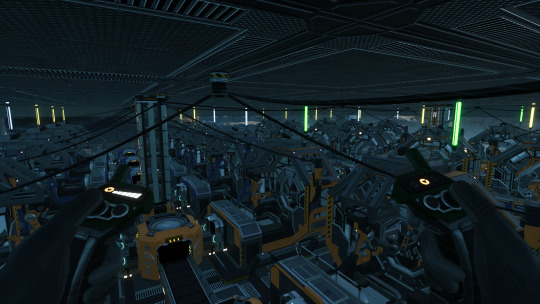
Fifth floor, AI limiters and stators. Yes, on the same floor, because it occurred to me that there was no logical reason to put them on separate floors. But now I wonder if another half-floor would have been so bad. Stators in back, AI limiters in front.

The prefabs include built-in logistics floors, and conveyor supports for the inputs, assuming everything, er, enters the same way. And those go up to...
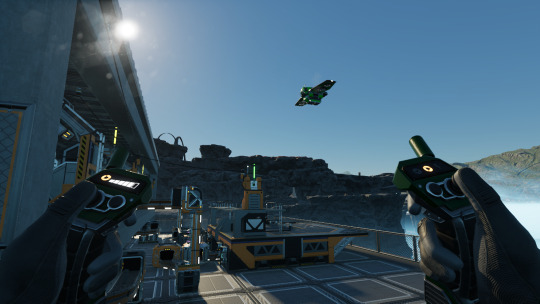
Top floor, ECR final join and dispatch. I have kluged up two drone ports at the reactor to receive these, and also supply said drones with fuel rods for plenty of power.
So that's my first true Stack! So what came before?
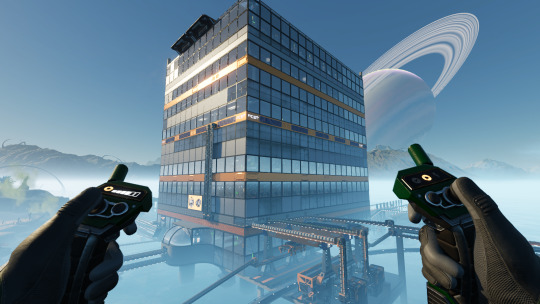
This is what came before: This damnable thick square building that makes parts for and does final join on modular engines and adaptive control units. On top are five drone ports. One receives fuel for the others. The two we can see receive smart plating and automated wiring. And there's that train station at the bottom of a rather entertaining ramp. Let's look inside.

Cool! We have a satellite HUB terminal (from a mod), and all other mod cons! Not to mention well-lit, at least in these lower floors, I skipped lighting as I went up and got impatient.
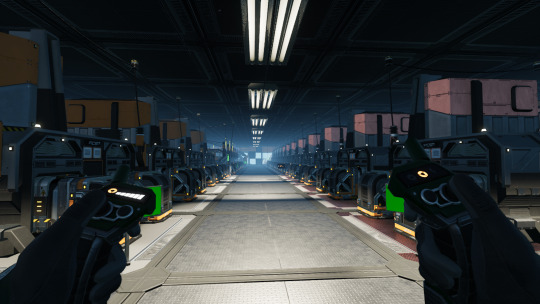
So many foundries and coated iron plate assemblers. Oh, and steel beam constructors.
I can't wait for the day when 1.1 is made mod friendly. This form of compact vertical transport is... well, it's not the going-up, it's the going-down. A 20m drop is hair-raising.

Silicon circuit boards and so, so many screws. There's about eight belts of them going up the south wall.
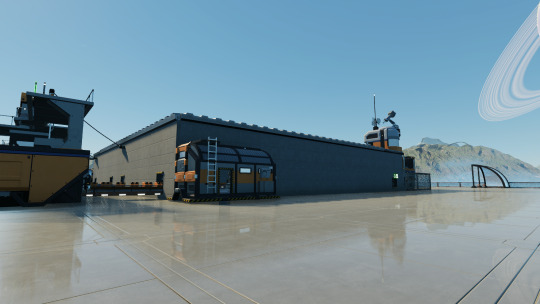
And this is where everything ends up: the roof. That building in the centre is where all the spaghet for dispatching the Phase 3 goods and receiving Phase 2 is. And dispensing fuel. And feeding the sink. While we're up here, let's look around:

So many miners! Copper, iron, limestone, it's all here and all getting exploited a mile into the ground.
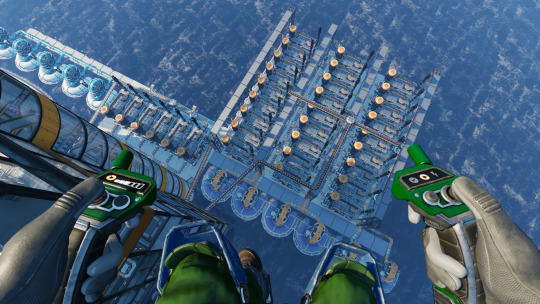
In back of the tower are the wet concrete refineries on the left, and the steamed copper sheet works. These were difficult to make, since I was, apparently, right on the edge of where I could place water extractors.

The mighty metal-roofed motor factory system! In the back, the double A-frame houses the solid steel ingot foundries; each different roofline indicates a separate stage of motor production. Copper ingots are belted in to a wire factory in the foreground.
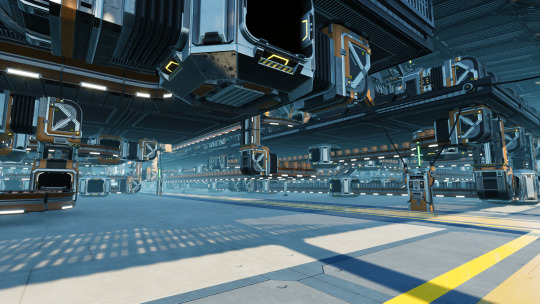
The ground floor is marked with a coloured floor and path patterns, to highlight where you can walk from one end of Rocky Desert Motors to the other.

All of these constructors are making screws. All 64 of them. So. Many. Screws. If I didn't know any better, I'd think I was running Satisfactory+.

And here we have a distant shot of the abominations I made on the West Coast. There's a basic aluminium ingot factory, spagged to a hastily made heat sink factory and fuel packing plant, and also a massive refinery for making residual rubber and plastic to feed the tower. Coke, rubber and plastic are supplied by train, obviously. There's also a little fuel power plant that I really need to either redo or replace.
Actually this whole shebang desperately needs reworking. If I can rework the plant to make recycled rubber and plastic, that should improve output immensely.
Aaand that's where I am right now. In my pad of Warwick 14J5 I have a plan for a grid system that I can use to rebuild Factory Town... but first I have some more damned mining to do. I promised my passengers I'd have them in the North America Nebula by Easter.
Also, over Easter and possibly starting Wednesday, I'm going to reset Windows and see if that fixes the stability issues I've been having while streaming. Which means ensuring all my documents are backed up. So excuse me, I have to take my Type 8 Ye Olde Rock Thudder out to do just that...
2 notes
·
View notes
Text
AI & IT'S IMPACT
Unleashing the Power: The Impact of AI Across Industries and Future Frontiers
Artificial Intelligence (AI), once confined to the realm of science fiction, has rapidly become a transformative force across diverse industries. Its influence is reshaping the landscape of how businesses operate, innovate, and interact with their stakeholders. As we navigate the current impact of AI and peer into the future, it's evident that the capabilities of this technology are poised to reach unprecedented heights.
1. Healthcare:
In the healthcare sector, AI is a game-changer, revolutionizing diagnostics, treatment plans, and patient care. Machine learning algorithms analyze vast datasets to identify patterns, aiding in early disease detection. AI-driven robotic surgery is enhancing precision, reducing recovery times, and minimizing risks. Personalized medicine, powered by AI, tailors treatments based on an individual's genetic makeup, optimizing therapeutic outcomes.
2. Finance:
AI is reshaping the financial industry by enhancing efficiency, risk management, and customer experiences. Algorithms analyze market trends, enabling quicker and more accurate investment decisions. Chatbots and virtual assistants powered by AI streamline customer interactions, providing real-time assistance. Fraud detection algorithms work tirelessly to identify suspicious activities, bolstering security measures in online transactions.
3. Manufacturing:
In manufacturing, AI is optimizing production processes through predictive maintenance and quality control. Smart factories leverage AI to monitor equipment health, reducing downtime by predicting potential failures. Robots and autonomous systems, guided by AI, enhance precision and efficiency in tasks ranging from assembly lines to logistics. This not only increases productivity but also contributes to safer working environments.
4. Education:
AI is reshaping the educational landscape by personalizing learning experiences. Adaptive learning platforms use AI algorithms to tailor educational content to individual student needs, fostering better comprehension and engagement. AI-driven tools also assist educators in grading, administrative tasks, and provide insights into student performance, allowing for more effective teaching strategies.
5. Retail:
In the retail sector, AI is transforming customer experiences through personalized recommendations and efficient supply chain management. Recommendation engines analyze customer preferences, providing targeted product suggestions. AI-powered chatbots handle customer queries, offering real-time assistance. Inventory management is optimized through predictive analytics, reducing waste and ensuring products are readily available.
6. Future Frontiers:
A. Autonomous Vehicles: The future of transportation lies in AI-driven autonomous vehicles. From self-driving cars to automated drones, AI algorithms navigate and respond to dynamic environments, ensuring safer and more efficient transportation. This technology holds the promise of reducing accidents, alleviating traffic congestion, and redefining mobility.
B. Quantum Computing: As AI algorithms become more complex, the need for advanced computing capabilities grows. Quantucm omputing, with its ability to process vast amounts of data at unprecedented speeds, holds the potential to revolutionize AI. This synergy could unlock new possibilities in solving complex problems, ranging from drug discovery to climate modeling.
C. AI in Creativity: AI is not limited to data-driven tasks; it's also making inroads into the realm of creativity. AI-generated art, music, and content are gaining recognition. Future developments may see AI collaborating with human creators, pushing the boundaries of what is possible in fields traditionally associated with human ingenuity.
In conclusion, the impact of AI across industries is profound and multifaceted. From enhancing efficiency and precision to revolutionizing how we approach complex challenges, AI is at the forefront of innovation. The future capabilities of AI hold the promise of even greater advancements, ushering in an era where the boundaries of what is achievable continue to expand. As businesses and industries continue to embrace and adapt to these transformative technologies, the synergy between human intelligence and artificial intelligence will undoubtedly shape a future defined by unprecedented possibilities.
20 notes
·
View notes
Text
Industrial Automation and Control
A manufacturing plant's integration of diverse devices, machinery, and equipment forms the basis of industrial automation control systems. However, as previously indicated, they might go one step further and integrate the manufacturing floor system with the rest of the business.
#Energy and Power Automation Solutions#Special Purpose Machine Automation | AI-based vision sensors#Warehouse Automation Solutions#Material Handling Processes#Partner in Factory Automation#Electrical & software solutions#Process Automation Partner
0 notes
Text
𝐇𝐨𝐰 𝐀𝐈 𝐚𝐧𝐝 5𝐆 𝐀𝐫𝐞 𝐓𝐫𝐚𝐧𝐬𝐟𝐨𝐫𝐦𝐢𝐧𝐠 𝐁𝐮𝐬𝐢𝐧𝐞𝐬𝐬 𝐆𝐫𝐨𝐰𝐭𝐡 | 𝐓𝐡𝐞 𝐅𝐮𝐭𝐮𝐫𝐞 𝐨𝐟 𝐈𝐧𝐧𝐨𝐯𝐚𝐭𝐢𝐨𝐧
The fusion of AI and 5G is revolutionizing businesses worldwide. With ultra-fast connectivity and real-time data analytics, companies are unlocking new opportunities for efficiency, automation, and customer engagement.
Learn how AI and 5G work together to:
Enhance real-time decision-making
Improve IoT connectivity for smart industries
Power AI-driven automation and predictive analytics
Personalize customer experiences like never before
From smart factories to AI-powered healthcare, discover how these technologies are shaping the future of business. Don't miss out—watch now - https://youtu.be/w1nDoqzVj0g
Follow for more tech insights.
#ai#5g#businessgrowth#innovation#futuretech#iot#automation#digitaltransformation#smarttechnology#bigdata
2 notes
·
View notes
Text
How 5g Technology Change The World
The world is getting ready to a technological revolution, and on the coronary heart of this alteration is 5G era. As the 5th generation of mobile networks, 5G guarantees extremely-speedy speeds, low latency, and extraordinary connectivity. This advancement is ready to reshape industries, improve every day existence, and create new opportunities across more than one sectors. From healthcare and transportation to entertainment and clever towns, 5G isn't always simply an upgrade; it's miles a catalyst for a brand new virtual generation.

what is 5g and how it works
The Fundamentals of 5G Technology
5G era is designed to provide extensively faster information speeds than its predecessor, 4G LTE. It operates on three special spectrum bands:
Low-band spectrum – Provides broad coverage however with highly slower speeds.
Mid-band spectrum – Offers a balance between pace and insurance.
High-band spectrum (millimeter-wave) – Delivers extremely fast speeds but has confined range.
With information speeds attaining up to 10 Gbps, 5G networks will enable seamless connectivity, permitting gadgets to communicate in actual-time with minimum delay (latency as little as one millisecond). This bounce in community functionality will pave the manner for improvements that had been previously impossible.
Transforming Industries
1. Healthcare
5G technology is revolutionizing the healthcare industry through allowing faraway surgical procedures, telemedicine, and real-time affected person tracking. With ultra-low latency and high-speed connectivity, surgeons can perform robotic surgical procedures from different elements of the world, expanding get admission to to existence-saving techniques. Additionally, 5G allows for stepped forward records transfer between clinical devices, ensuring timely prognosis and higher affected person care.
2. Smart Cities and Infrastructure
5G is a key aspect inside the improvement of smart towns. By connecting billions of gadgets through the Internet of Things (IoT), 5G lets in for efficient visitors management, smart lighting, and waste management structures. Autonomous motors will gain from actual-time verbal exchange with traffic indicators and different cars, reducing injuries and improving traffic waft. Cities will become more sustainable, energy-green, and safer for citizens.
Three. Manufacturing and Automation
The manufacturing quarter is undergoing a transformation with the appearance of 5G. Smart factories prepared with AI-powered robots and IoT gadgets will operate with minimum human intervention. Predictive renovation powered by means of real-time records will reduce downtime and decorate productiveness. Augmented fact (AR) and virtual reality (VR) packages will streamline employee education and improve efficiency on manufacturing unit flooring.
4. Entertainment and Media
The enjoyment industry is also experiencing a shift with 5G generation. High-definition streaming, cloud gaming, and immersive AR/VR reviews becomes the norm. With minimal buffering and high-speed connectivity, customers can enjoy seamless content intake. Additionally, 5G allows real-time interaction in stay events and esports, offering a more engaging experience for audiences worldwide.
5. Education and Remote Work
5G is gambling a crucial function inside the evolution of schooling and far off work. Virtual lecture rooms, interactive gaining knowledge of modules, and terrific video conferencing are becoming greater accessible. Students in faraway regions can advantage from advanced internet connectivity, bridging the virtual divide. Businesses, however, can put into effect flexible paintings models with uninterrupted video calls and faster cloud get entry to, boosting productivity and performance.
The Impact of 5G on Everyday Life
Beyond industries, 5G will significantly enhance normal reviews. Smart houses prepared with 5G-enabled IoT devices will provide better safety, energy management, and comfort. Personal assistants, consisting of AI-powered voice assistants, will become extra responsive and intuitive. Augmented fact packages will remodel purchasing experiences with the aid of allowing consumers to visualise products earlier than buying.
Moreover, the gaming industry will see a shift in the direction of cloud gaming platforms, wherein high-cease gaming reports are handy with out the need for steeply-priced hardware. With decreased latency, multiplayer gaming will become smoother, allowing gamers to compete in real time with minimal disruptions.
Challenges and Concerns
While the advantages of 5G are plain, there also are demanding situations that need to be addressed. Some of the key concerns consist of:
Infrastructure Development – The deployment of 5G calls for a big funding in new infrastructure, including small cell towers and fiber-optic networks.
Security and Privacy – With accelerated connectivity comes the hazard of cyber threats. Ensuring sturdy safety features is essential to shield user statistics and prevent cyberattacks.
Health Concerns – There have been debates regarding the capability fitness risks associated with 5G radiation. However, clinical research have now not observed conclusive proof linking 5G to health troubles.
Digital Divide – While urban areas may enjoy fast 5G adoption, rural and underserved areas may additionally face delays in deployment, probably widening the virtual divide.
The Future of 5G
The destiny of 5G era seems promising as countries and agencies continue to invest in its improvement. With advancements in artificial intelligence, side computing, and quantum computing, 5G will release even more opportunities. The transition to 6G in the coming years will in addition push the limits of connectivity, making futuristic concepts consisting of holographic verbal exchange and brain-computer interfaces a fact.
Affordable smartphones with best camera reviews
2 notes
·
View notes
Text
Pluto in Aquarius: The Last Time This Happened, the World Changed Forever—It’s Happening Again Now
Alright, let’s talk Pluto in Aquarius—because every time this cosmic wrecking ball hits this sign, the world proper kicks off. We’re talking revolutions, radical tech shifts, power struggles, and entire systems collapsing. And guess what? We’ve just stepped into this energy from 2023 to 2044.
The last time Pluto did this dance? The late 1700s. Yeah—when people chopped off monarchs’ heads, tore down old regimes, and started talking about democracy, human rights, and freedom. The time before that? The 1500s, when religious power crumbled, the printing press spread radical ideas, and science told the Church to get lost.
So buckle up—because this isn’t just astrology, this is historical patterning, and it’s wild.
1777–1798: The Age of Revolutions
This was Pluto’s last trip through Aquarius, and the world went upside down.
1. The American Revolution (1776–1783)
The USA was literally born under Pluto in Aquarius. Before this, monarchs ruled like they were put there by God. Then the American colonies went, “Nah, we’ll do it ourselves”, kicked Britain out, and built a democratic republic. It was the first time people properly rejected monarchy and demanded self-rule.
2. The French Revolution (1789–1799)
And then France took things to the extreme. People were starving, the monarchy and aristocracy hoarded wealth, and then Pluto in Aquarius said, “Right, get rid of ‘em.”
• The Bastille was stormed.
• The Declaration of the Rights of Man and of the Citizen was signed.
• King Louis XVI and Marie Antoinette? Beheaded.
• A full-on anti-royal, anti-elite revolution exploded.
People weren’t just annoyed—they abolished the monarchy and completely restructured society.
3. The Industrial Revolution Kicked Off
While people were busy overthrowing kings, Pluto in Aquarius also went, “Let’s speed up human progress.”
• Steam engines started running factories.
• Machines replaced manual labour.
• People left farms for cities, and modern industry was born.
This was the birth of automation, and it changed work forever. It wasn’t just a tech upgrade—it was a societal upheaval.
4. The Haitian Revolution (1791–1804)
This one’s massive but often overlooked. The enslaved people of Haiti said, “We’re done.” They rose up, fought off their French rulers, and became the first free Black republic. It was the only successful slave revolt in history that actually led to a country gaining independence.
Pluto in Aquarius = Power shifts. Old orders crumble. People take control.
1532–1553: The Reformation & Scientific Breakthroughs
Going back even further, we see Pluto in Aquarius smashing the religious elite and introducing big ideas that reshaped the world.
1. The Protestant Reformation (1534 Onwards)
Before this? The Catholic Church owned Western Europe. If you weren’t Catholic, you were a heretic. Enter Pluto in Aquarius.
• Henry VIII split from the Pope and created the Church of England—just because he wanted a divorce.
• Martin Luther had already kicked off the Protestant Reformation (1517), challenging the Church’s authority.
• The Bible was translated into local languages, so regular people could read it instead of just priests.
The religious monopoly collapsed. Power shifted from the Church to the people.
2. Science Told the Church to Sit Down
• Copernicus published De revolutionibus (1543), proving the Earth orbits the Sun. Before this? The Church had spent centuries saying the Sun revolved around Earth.
• The printing press spread new ideas FAST. Before, knowledge was locked up by the elite. Now? Anyone could learn.
Pluto in Aquarius again—disrupting power structures and accelerating human progress.
2023–2044: What’s Happening Now?
So we’ve just entered another Pluto in Aquarius era, and we’re already seeing the same patterns:
1. Digital & AI Revolution
In the 1700s, Pluto in Aquarius gave us steam power and industry. Now? AI, automation, and the next phase of technology.
• AI is already replacing jobs—just like machines did in the 1700s.
• Decentralization is rising—people want power away from governments and corporations.
• Cryptocurrency, digital governance, and automation are reshaping money and control.
This isn’t just new tech—it’s a societal shift in how we work, think, and operate.
2. Political & Social Upheaval
Governments are struggling to keep control—people are demanding freedom, autonomy, and new systems.
• Protests are happening everywhere—from Iran to the US, from France to China.
• Monarchies & old power structures are weakening.
• People are rejecting elite control.
Much like in the late 1700s, Pluto in Aquarius is challenging those in power.
3. Space & Scientific Breakthroughs
• Private companies (like SpaceX) are taking over space travel.
• We’re closer than ever to AI merging with humans (Neuralink, robotics, biotech).
• Fusion energy & quantum computing are on the horizon.
Pluto in Aquarius doesn’t just change society—it pushes science and tech beyond what we thought was possible.
What Happens Next?
Pluto in Aquarius always brings power shifts, decentralization, and disruption. Looking at history, we can expect:
✔ More technological revolutions.
✔ People reclaiming power from elite structures.
✔ Radical new governance ideas—maybe digital democracy, AI-led systems, or something we can’t even imagine yet.
✔ Space colonization accelerating.
✔ Massive job transformations—just like the Industrial Revolution.
But here’s the thing—Pluto doesn’t care if you’re ready. It just changes everything.
So, like it or not, the old world is ending, and something entirely new is emerging.
Are you going to fight for the future—or cling to the past? Because Pluto in Aquarius doesn’t do nostalgia. It’s already moving forward.
🔥 Your Thoughts?
Feeling this shift already? What’s the wildest change you think we’ll see? 🚀👇
Follow The Lantern’s
Glow
6 notes
·
View notes